
Timely Comics is the common name for the group of corporations that was the earliest comic book arm of American publisher Martin Goodman, and the entity that would evolve by the 1960s to become Marvel Comics.
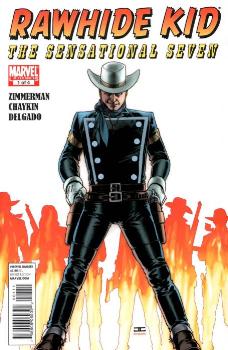
The Rawhide Kid is a fictional Old West cowboy appearing in American comic books published by Marvel Comics. A heroic gunfighter of the 19th-century American West who was unjustly wanted as an outlaw, he is one of Marvel's most prolific Western characters. He and other Marvel western heroes have on rare occasions guest-starred through time travel in such contemporary titles as The Avengers and West Coast Avengers. In two mature-audience miniseries, in 2003 and 2010, he is depicted as gay.
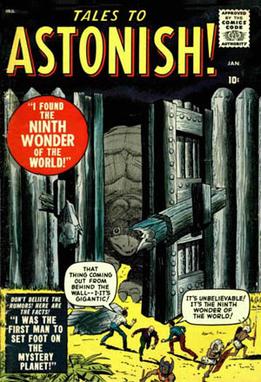
Tales to Astonish is the name of two American comic book series, and a one-shot comic, all published by Marvel Comics.
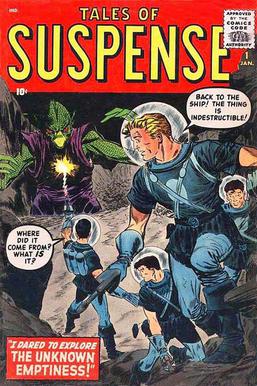
Tales of Suspense is the name of an American comic book anthology series, and two one-shot comics, all published by Marvel Comics. The first, which ran from 1959 to 1968, began as a science-fiction anthology that served as a showcase for such artists as Jack Kirby, Steve Ditko, and Don Heck, then featured superheroes Captain America and Iron Man during the Silver Age of Comic Books before changing its title to Captain America with issue #100. Its sister title was Tales to Astonish. Following the launch of Marvel Legacy in 2017, Tales of Suspense was once again resurrected at issue #100, featuring the Winter Soldier and Hawkeye in a story called "The Red Ledger".
Strange Tales is a Marvel Comics anthology series. The title was revived in different forms on multiple occasions. Doctor Strange and Nick Fury, Agent of S.H.I.E.L.D. made their debuts in Strange Tales. It was a showcase for the science fiction/suspense stories of artists Jack Kirby and Steve Ditko, and for the groundbreaking work of writer-artist Jim Steranko. Two previous, unrelated magazines also bore that title.
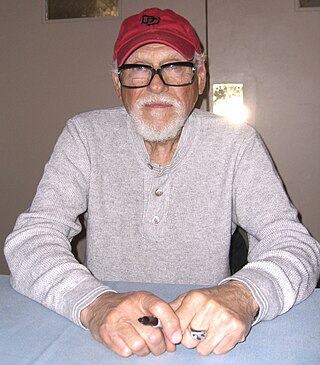
Eugene Jules Colan was an American comic book artist best known for his work for Marvel Comics, where his signature titles include the superhero series Daredevil, the cult-hit satiric series Howard the Duck, and The Tomb of Dracula, considered one of comics' classic horror series. He co-created the Falcon, the first African-American superhero in mainstream comics; Carol Danvers, who would become Ms. Marvel and Captain Marvel; and the non-costumed, supernatural vampire hunter Blade.

Marvel Mystery Comics is an American comic book series published during the 1930s–1940s period known to fans and historians as the Golden Age of Comic Books. It was the first publication of Marvel Comics' predecessor, Timely Comics, a division of Timely Publications.
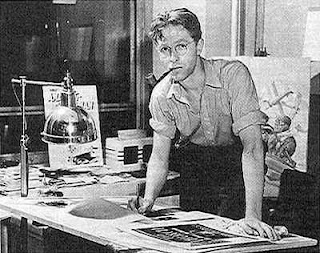
William Blake Everett was an American comic book writer-artist best known for creating Namor the Sub-Mariner as well as co-creating Zombie and Daredevil with writer Stan Lee for Marvel Comics. He was allegedly a descendant of the childless poet William Blake and of Richard Everett, founder of Dedham, Massachusetts.
Carl Burgos was an American comic book and advertising artist best known for creating the original Human Torch in Marvel Comics #1, during the period historians and fans call the Golden Age of comic books.
Sydney Shores was an American comic book artist known for his work on Captain America both during the 1940s, in what fans and historians call the Golden Age of comic books, and during the 1960s Silver Age of comic books.

Atlas Comics is the 1950s comic-book publishing label that evolved into Marvel Comics. Magazine and paperback novel publisher Martin Goodman, whose business strategy involved having a multitude of corporate entities, used Atlas as the umbrella name for his comic-book division during this time. Atlas evolved out of Goodman's 1940s comic-book division, Timely Comics, and was located on the 14th floor of the Empire State Building. This company is distinct from the 1970s comic-book company, also founded by Goodman, that is known as Atlas/Seaboard Comics.

Jack Abel was an American comic book artist best known as an inker for leading publishers DC Comics and Marvel Comics. He was DC's primary inker on the Superman titles in the late 1960s and early 1970s, and inked penciler Herb Trimpe's introduction of the popular superhero Wolverine in The Incredible Hulk #181. He sometimes used the pseudonym Gary Michaels.

Marvel Super-Heroes is the name of several comic book series and specials published by Marvel Comics.
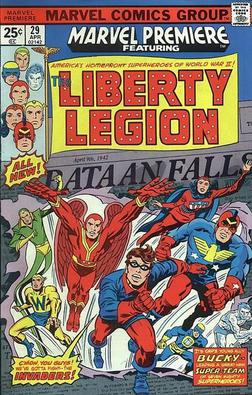
The Liberty Legion is a fictional superhero team appearing in American comic books published by Marvel Comics. The team was first created in 1976 and set during World War II. Composed of existing heroes from Marvel's 1940s Golden Age of Comic Books predecessor, Timely Comics, the team was assembled and named by writer Roy Thomas in a story arc running through The Invaders #5–6 and Marvel Premiere #29–30. Inspired by the Liberty Legion, a second fictional team called the Liberteens was published in 2007 as part of the Avengers Initiative.
Red Raven is the name of three separate fictional characters appearing in American comic books published by Marvel Comics. These characters are the original Red Raven, a flying superhero, who appeared in print once in 1940, then not again until 1968, and occasionally since then; the second Red Raven, named Dania, who is a flying superhero and daughter of the original Red Raven, who first appeared in print in 1992, and occasionally since then; and Redford Raven, a Wild West villain who owned a set of medicine-enchanted wings, was also called Red Raven, and has appeared in print three times, in 1964, 1985, and 1987.
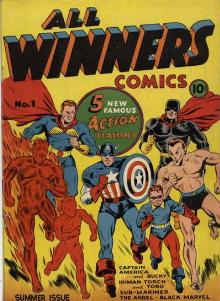
All Winners Comics was the name of two American comic book series of the 1940s, both published by Marvel Comics' predecessor, Timely Comics, during the period fans and historians call the Golden Age of Comic Books. A superhero anthology comic in both cases, they variously featured such star characters as Captain America, the original Human Torch, and the Sub-Mariner. All Winners Comics was also the venue for two full-length stories of Marvel's first superhero team, the (hyphenated) All-Winners Squad.
Al Gabriele was an American comic book artist during the 1940s period fans and historians call the Golden Age of comic books. He was known for his work on some of Marvel Comics' earliest Captain America and Sub-Mariner stories, and for co-creating the company's superheroes Black Marvel, Miss America, and possibly, the Whizzer.
Mystic Comics is the name of three comic book series published by the company that eventually became Marvel Comics. The first two series were superhero anthologies published by Marvel's 1930-1940s predecessor, Timely Comics, during what fans and historians call the Golden Age of comic books. The third, simply titled Mystic, was a horror fiction-suspense anthology from Marvel's 1950s forerunner, Atlas Comics.

Menace was a 1953 to 1954 American crime/horror anthology comic book series published by Atlas Comics, the 1950s precursor of Marvel Comics. It is best known for the first appearance of the supernatural Marvel character the Zombie, in a standalone story that became the basis for the 1970s black-and-white comics magazine Tales of the Zombie. As well, a standalone story in the final issue introduced a robot character that was revived decades later as the Human-Robot, a.k.a. M-11, the Human-Robot.
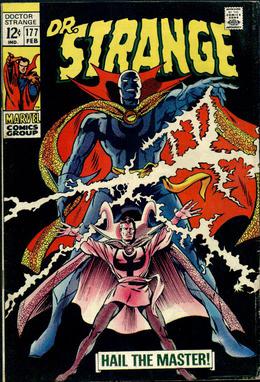
Doctor Strange is a series of several comic book volumes featuring the character Doctor Strange and published by Marvel Comics, beginning with the original Doctor Strange comic book series that debuted in 1968.














